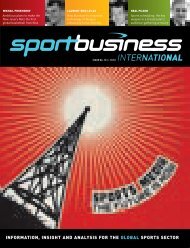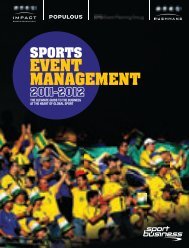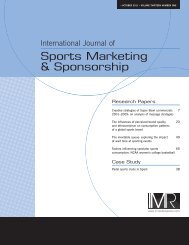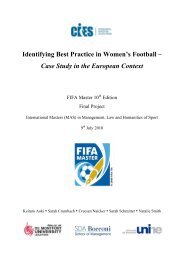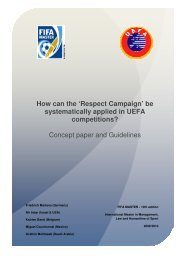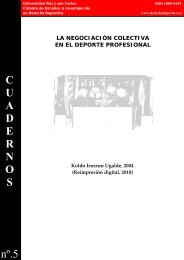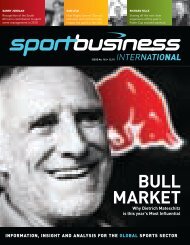Sports Marketing & Sponsorship - FIFA/CIES International University ...
Sports Marketing & Sponsorship - FIFA/CIES International University ...
Sports Marketing & Sponsorship - FIFA/CIES International University ...
- No tags were found...
Create successful ePaper yourself
Turn your PDF publications into a flip-book with our unique Google optimized e-Paper software.
Stade Français Paris rugby clubCASE STUDYImplementationStrategic marketingAs stated by Kotler et al (2004), strategic marketingrelies on three elements: segmentation, targeting andpositioning. Segmentation consists of clustering amarket in several homogeneous groups, which areboth significant and accessible to marketing activity(Kotler et al, 2004). In the case of SF Paris, the firstquestion concerns which market the club is competingin (Couvelaere & Richelieu, 2005). Indeed, as withprofessional sports clubs in general, SF Pariscompetes in several markets, namely the rugby unionmarket, the professional sports market and finally thebroad leisure and entertainment market (Euchner,1993; Mason, 1999).As far as the rugby union market is concerned, theintensity of competition can be determined throughanalysis of different levels of the sport. At the nationallevel, the main competitors for SF Paris are based inthe south of France, i.e. the area south of the Loireriver, and in south-west France in particular (Boure,2004; Charlot, 2006). The main rivals, in terms ofboth field performance and image, are StadeToulousain, Biarritz Olympique, Clermont-Auvergneand USA Perpignan. SF Paris is the only clubgeographically situated in the ‘north’, and this partiallycontributes to the cultural rivalry between the capitaland the provinces. The south is considered to be thehome of rugby union, and the spirit of rugby is oftencharacterised as a sport of villages or ‘clock towers’,meaning that it is territorially (Boure, 2004; Charlot,2006) and culturally attached to ‘peasant’ values(Pociello, 1983). At a local level, there is only oneother professional club situated in the Paris region, l’Ilede France. Racing-Metro, which along with SF Paris isone of the oldest French sports clubs, plays in thesecond division with a home ground capacity of6,500 seats and an average attendance of 1,141 forthe regular season 2006-07 (LNR).In the general professional sports market, SF Paris’smain regional competitor is Paris Saint Germain (PSG)football club, although other team sports such asbasketball, handball, volleyball and ice-hockey have atleast one first division professional club. However, it isdebatable whether they truly compete, given thatfootball and rugby have very different fan profiles.Finally, as an entertainment activity, we canconsider that SF Paris competes in the leisure marketand, more specifically, is an alternative choice forSaturday night activities such as theatre, cinema orgoing out (Euchner, 1993; Mason, 1999).The principle of segmentation highlights thedifference between groups of customers. It does so inorder to select which segments fit the company’sproduct and which are profitable (Kotler et al, 2004).In order to investigate the marketing strategy of SFParis, it is legitimate to focus on several frameworksthat might help us to understand the demand for thesport spectacle, and then which segments weretargeted by SF Paris.Thus, in relation to the sports spectacle, Holt(1995) identified four types of practices which aredefined as consumption metaphors. The first onedefines consuming-as-experience and highlights theconsumer’s subjective and emotional reactions andparticularly the experiential, aesthetic, autotelic andhedonic dimensions of consumption (Holbrook &Hirschman, 1982). The second metaphor, consumingas-integration,describes “how consumers acquire andmanipulate object meanings” thanks to their symbolicdimension (Holt, 1995). The third highlights theclassification role of consumption in general and thesports spectacle in particular. Finally, consuming-asplayrefers to the way consumers use consumptionobjects to interact, socialise and share commonexperiences. Although this framework constitutes thefirst step to understanding what consumers of sportsspectacles look for, it did not allow us to createmarketing segments, because most spectators useconsumption for several meanings. However,Bourgeon & Bouchet (2001) extended the work ofHolt (1995), and produced a semiotic squareproviding four consumer profiles of sports spectacles.The ‘aesthete’ profile characterised customers wholook for the quality of the game, the beauty of the254 <strong>International</strong> Journal of <strong>Sports</strong> <strong>Marketing</strong> & <strong>Sponsorship</strong> ● APRIL 2009 ●



